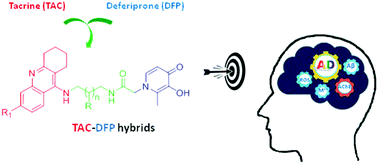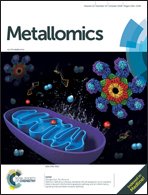Tacrine–deferiprone hybrids as multi-target-directed metal chelators against Alzheimer's disease: a two-in-one drug†
Abstract
Alzheimer's disease (AD) is a severe age-dependent neurodegenerative disorder affecting several million people worldwide. So far, there is no adequate medication to prevent or slow down the progression of the disease, only medication with palliative effects allowing temporary symptomatic reliefs. As part of our continuing efforts into the development of innovative drugs following a polypharmacological strategy, we decided to use a former anti-AD palliative drug (tacrine) and to reposition it by hybridization with a metal chelating drug (deferiprone, DFP). This combination endows the hybrids with good capacity to inhibit acetylcholinesterase (low micromolar range) and self-/Cu-induced Aβ aggregation (up to ca. 90%) as well as a good radical scavenging ability (micromolar range) and metal (M) chelating capacity, with pM (pM = −log[M], CL/CM = 10, CM = 10−6 M at pH = 7.4, M = Fe, Cu, Zn) values close to those of DFP. The most promising compounds have 2-hydroxypropyl linkers, and a selection of compounds have demonstrated neuroprotective roles in neuroblastoma cells treated with Aβ1–42 and ascorbate/iron stressors. Consequently, these hybrids can be considered as attractive multipotent therapeutic molecules that will eventually play key roles against AD progression, namely in the control of cholinergic dysfunction, amyloid peptide aggregation, oxidative stress, and metal modulation, besides presenting a good pharmacokinetic profile.



 Please wait while we load your content...
Please wait while we load your content...